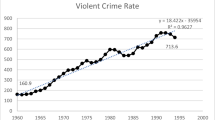Abstract
This article employs a convict perspective toexamine the evolving nature of imprisonment inthe United States. Drawing from the prisonliterature, and placed within the politicaleconomy of the wider society, it utilizespersonal accounts of the author (an ex-convict)and his interactions with prisoners to providea critical look at the changing structures,inequities, and hierarchical social relationsof the prison system and their effect on thelives of people behind bars.
Similar content being viewed by others
References
Abramsky, Sasha (2002, February 11). Return of the madhouse: Super max prisons are becoming the high-tech equivalent of the nineteenth-century snake pit. American Prospect, 26.
Abu-Jamal, Mumia (2000). The industry of fear. Social Justice 7(3), 22–24.
American Friends Service Committee (1997). Survivors Manual. Newark, New Jersey: American Friends Service Committee and the Human Rights Committee California Prison Focus.
Austin, James and Irwin, John (2001). It’s About Time: America’s Imprisonment Binge. Belont, California: Wadsworth.
Bazemore, Gordon and Schiff, Mara (2001). Restorative Community Justice: Repairing Harm and Transforming Communities. Cincinnati, Ohio: Anderson.
Beckett, Katherine and Sasson, Theodore (2000). The Politics of Injustice: Crime and Punishment in America. Thousand Oaks, California: Pine Forge Press.
Brotman, Jill (1998). The scandal of prison “management.” In Daniel Burton-Rose, Dan Pens and Paul Wright (eds.), The Celling of America: An Inside Look at the U.S. Prison Industry. Monroe, Maine: Common Courage Press, pp. 197–199.
Christy, Nils (1993). Crime Control as Industry: Toward Gulags, Western Style? London: Routledge.
Clemmer, Donald (1940). The Prison Community. New York: Holt, Rinehart, and Winston.
Cook, Rhonda (2002, February 21). Suit claims prison abuse of retarded, mentally ill. Atlantic Journal and Constitution.
Gabler, Neal (2002, January 27). Class dismissed:Whatever happened to the politics of pitting the haves against the have nots? Los Angeles Times.
Garland, David and Sparks, Richard (2000). Criminology, social theory and the challenge of our times. In David Garland and Richard Sparks (eds.), Criminology and Social Theory. New York: Oxford University Press, pp. 1–22.
Hakim, Danny (2002, July 10). For flint, Michigan, takeover adds to list of woes. New York Times, Section A, p. 12, column 1.
Hamm, Mark, Coupez, Therese, Hoze, Frances E. and Weinstein, Corey (1994). The myth of humane imprisonment: A critical analysis of severe discipline in U.S. maximum security prisons, 1945-1990. In Michael C. Braswell, Reid H. Montgomery, Jr. and Lucien X. Lombardo (eds.), Prison Violence in America (2nd ed.). Cincinnati, Ohio: Anderson, pp. 167–200.
Hay, Douglas (1975). Albion’s Fatal Tree: Crime and Society in Eighteenth-Century England. New York: Pantheon.
Hughes, Robert (1988). The Fatal Shore: The Epic of Australia’s Founding. New York: Random House.
Hunt, Geoffrey, Riegel, Stephanie, Morales, Tomas and Waldorf, Dan (1993). Changes in prison culture: Prison gangs and the case of the “pepsi generation.” Social Problems 40(3), 398–409.
Irwin, John (1970). The Felon. Englewood Cliffs, New Jersey: Prentice-Hall.
Irwin, John (1980). Prisons in Turmoil. Boston: Little, Brown.
Irwin, John (2003). Preface. In Jeffrey Ian Ross and Stephan C. Richards (eds.), Convict Criminology. Belmont, California: Wadsworth, pp. xvii–xxii.
Jones, Richard S. (1995). Uncovering the hidden social world: Insider research in prison. Journal of Contemporary Criminal Justice 11, 106–118.
Kupers, Terry A. (1999). Prison Madness: The Mental Health Crisis Behind Bars and What We Must Do about It. San Francisco: Jossey-Bass.
Lopez, Jose (1996). Prisons as concentration camps: It can’t happen here-or can it? In Elihu Rosenblatt (ed.), Criminal Injustice; Confronting the Prison Crisis. Boston, Massachusetts: South End Press, pp. 254–268.
Maguire, Kathleen and Pastore, Ann L. (1999). Bureau of Justice Statistics: Sourcebook of Criminal Justice Statistics. Washington DC: U.S. Department of Justice.
Mauer, Marc (1999). Race to Incarcerate. New York: New Press.
McLaughlin, Philip (1998). Just say no? In Daniel Burton-Rose, Dan Pens and Paul Wright (eds.), The Celling of America: An Inside Look at the U.S. Prison Industry. Monroe, Maine: Common Courage Press, pp. 88–91.
Mead, Ed (2000). Reflections on crime and class. Social Justice 27(3), 11–14.
Mobley, Alan (2002). Personal communication.
Mobley, Alan (2003). Convict criminology: The two-legged data dilemma. In Jeffrey Ian Ross and Stephan C. Richards (eds.), Convict Criminology. Belmont, California: Wadsworth, pp. 209–225.
Newbold, Greg (1982). The Big Huey. Auckland, New Zealand: Collins.
Parenti, Christian (1999). Lockdown America: Police and Prisons in the Age of Crisis. London: Verso.
Parenti, Christian (2001). The “new” criminal justice system: State repression from 1968 to 2001. Monthly Review 53(3), 19–28.
Pens, Daniel and Wright, Paul (1998). Total power corupts: Guard racism and brutality. In Daniel Burton-Rose, Dan Pens and Paul Wright (eds.), The Celling of America: An Inside Look at the U.S. Prison Industry. Monroe, Maine: Common Courage Press, pp. 171–180.
Pepinsky, Harold and Quinney, Richard (1991). Criminology as Peacemaking. Bloomington: Indiana University Press.
Quinney, Richard (1970). The Social Reality of Crime. Boston: Little Brown.
Quinney, Richard (1974). Critique of the Legal Order: Crime Control in Capitalist Society. Boston: Little Brown.
Quinney, Richard (1980). Class, State, and Crime (2nd ed.). New York: Longman.
Quinney, Richard (1988). Beyond the interpretive: The way of awareness. Sociological Inquiry 58(1), 101–116.
Quinney, Richard (1991). The way of peace: On crime, suffering, and service. In Harold E. Pepinsky and Richard Quinney (eds.), Criminology as Peacemaking. Bloomington: Indiana University Press, pp. 3–13.
Quinney, Richard (1993). A life of crime: Criminology and public policy as peacemaking. Journal of Crime and Justice 16(2), 3–9.
Quinney, Richard (2001). Foreward. In Randall G. Shelden’s (ed.), Controlling the Dangerous Classes: A Critical Introduction to the History of Criminal Justice. Boston: Allyn and Bacon.
Richards, Stephan C. (1995). The Structure of Prison Release: An Extended Case Study of Prison Release, Work Release, and Parole. New York: McGraw Hill.
Rosenblatt, Elihu (1996). Criminal Injustice: Confronting the Prison Crisis. Boston, Massachusetts: South End Press.
Ross, Jeffrey Ian and Richards, Stephan C. (2003). Convict Criminology. Belmont, California: Wadsworth.
Rothman, David J. (1995). More of the same: American criminal justice policies in the 1990s. In Thomas G. Blomberge and Stanley Cohen (eds.), Punishment and Social Control: Essays in Honor of Sheldon L. Messinger. New York: Aldine De Gruyter, pp. 45–61.
Schlosser, Eric (1998). The prison industrial complex. The Atlantic Monthly 282(2), 81–82.
Shelden, Randall (2000). The American Gulag: The Emergence and Growth of the Prison Industrial Complex. Paper presented at the American Society of Criminology, San Francisco, CA.
Shelden, Randall (2001). Controlling the Dangerous Classes: A Critical Introduction to the History of Criminal Justice. Boston: Allyn and Bacon.
Shelden, Randall G. and Brown, William B. (2000). The crime control industry and the management of the surplus population. Critical Criminology 9(1-2), 39–62.
Simon, Jonathan and Feeley, Malcolm M. (1995). True crime: The new penology and public discourse on crime. In Thomas G. Blomberge and Stanley Cohen (eds.), Punishment and Social Control: Essays in Honor of Sheldon L. Messinger. New York: Aldine De Gruyter, pp. 147–180.
Spitzer, Steven (1975). Toward a Marxian theory of deviance. Social Problems 22, 638–651.
Sullivan, Dennis and Tifft, Larry (1998). Criminology as peacemaking: A peace-oriented perspective on crime, punishment, and justice that takes into account the needs of all. The Justice Professional 11(1-2), 5–34.
Sullivan, Dennis and Tifft, Larry (2001). Restorative Justice: Healing the Foundations of Our Everyday Lives. New York: Willow Tree.
Takagi, Paul (1975). The walnut street jail: A penal reform to centralize the powers of the state. Federal Probation (December), 18-26.
Terry, Charles M. (1999). A journey inside the criminal justice system: One man’s journey. In George F. Cole and Christopher Smith (eds.), Criminal Justice in America (2nd ed.). Belmont, California: Wadsworth, pp. 69–70, 147-148, 250-252, 347-349, 374-375.
Terry, Charles M. (2000). Beyond punishment: Perpetuating difference from the prison experience. Humanity and Society 24(2), 108–135.
Terry, Charles M. (2003a). The Fellas: Overcoming Prison and Addiction. Belmont, California: Wadsworth.
Terry, Charles M. (2003b). From C-block to academia: You can’t get there from here. In Jeffrey Ian Ross and Stephan C. Richards (eds.), Convict Criminology. Belmont, California: Wadsworth, pp. 95–119.
Tifft, Larry L. (2002). Crime and peace: A walk with Richard Quinney. Crime and Delinquency 48(2), 243–262.
Weber, Max (1984). Bureaucracy. In Frank Fischer and Carmen Sirianni (eds.), Critical Studies in Organization and Bureaucracy. Philadelphia: Temple University Press, pp. 24–39.
Welch, Michael (1999). Punishment in America: Social Control and the Ironies of Imprisonment. Thousand Oaks, California: Sage.
Wisely, W. (2000). The ride: Rise of the NLR. Prison Legal News 11(9), 13–15.
Wood, Daniel B. (1997, September 16). To keep peace, prisons allow race to rule. Christian Science Monitor.
Zehr, Howard (1990). Changing Lenses. Scottsdale, Pennsylvania: Herald Press.
Author information
Authors and Affiliations
Rights and permissions
About this article
Cite this article
Terry, C.M. Managing Prisoners as Problem Populations and the Evolving Nature of Imprisonment: A Convict Perspective. Crit Crim 12, 43–66 (2004). https://doi.org/10.1023/B:CRIT.0000024442.71190.c0
Issue Date:
DOI: https://doi.org/10.1023/B:CRIT.0000024442.71190.c0




